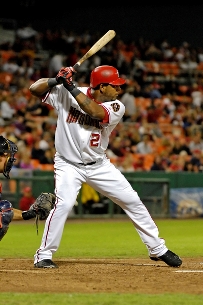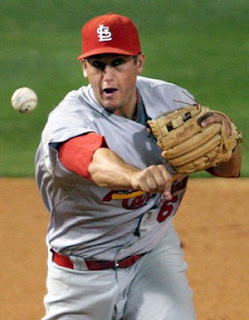Fortunately, with new owner Ed Crane in town, the team will have a shot to bring in some life. Sunday saw the departures of Wade and longtime president Tal Smith. Once a new GM is decided, manager Brad Mills and his coaching staff are believed to be on the chopping block as well.
There has been quite a bit of front office shuffling so far this offseason, with Baltimore, Minnesota, and Anaheim revamping their GM position, and Boston, San Diego and the Cubs entering a weird dance that saw three GMs and a President be appointed. The game is stocked with GMs-in waiting, and the Astros will have a tough decision to make, as there are many people in the game right now who are very qualified to take that job.
Here I will look at some of the most qualified people that the Astros should be looking at. I've broken the list into four categories: in-house options, current GMs, former GMs, and executives who have never been GMs. Let's start with the former.
In-House Options
David Gottfried: If anybody in the Astros organization deserves the job, it's Assistant and Interim GM David Gottfried. He has a long history of various management positions in the game, through the AFL and the minors, and has served in various capacities as an assistant at the major league level. One drawback to Gottfried is that his background is in delegation, not evaluation. With no real experience in either type of player evaluation (standard scouting or statistical analysis), Gottfried is not expected to hold the job, or even really be in competition for it.
Current General Managers
Andrew Friedman: Tampa Bay Rays GM Friedman is really the only option here, as most of the GMs in unstable positions have already moved around by now. Friedman is unanimously considered a top-few GM in all of professional sport, and quite possibly the best in all of baseball. He has experience in player development, is an incredibly smart man, has experience building teams, and even has Houston roots. In short, he would be perfect for the job, and you have to think that if Crane could just give it to anybody, it would be Friedman. In fact, he's the first man to whom they have obtained permission to speak. It is not impossible that he leaves Tampa Bay, but is also not likely. He has turned down many offers in the past, including several this offseason, some of which he has even declined to interview for. If there is a job in baseball that Friedman would take, one has to believe it would be Houston, but he has shown nothing but a desire to remain in Tampa in the past.
Former General Managers:
Gerry Hunsicker: Hunsicker should be a popular choice with the fans, because the last time he was a GM, he did his damndest to build a dynasty while serving as Astros GM from 1995-2004. He resigned following the 2004 season as his relationship when the then-owner Drayton McLane corroded, and has spent the last few seasons as a senior executive with the brilliantly-run Rays front office, and between the fact that he's done it before and the fact that he's hanging with the uber-modern guys with the Rays, there's no reason to not want him back. Will he want to come back to the Astros with a new ownership group?
Allard Baird: Baird had a less-than-successful stint with the Royals from 2000-2006, but has hung around the game (he is now with Boston), and has a history with classic evaluation, having served as head of both scouting and player personnel while with Boston since his dismissal from the Royals. Baird doesn't bring anything new to the table, but he's experienced in evaluation and in the front office game, if the Astros want to go that way.
JP Ricciardi: If it were up to me, Ricciardi would never sniff my GM chair. He proved slow to adapt and PR challenged while in Toronto, but he remains one of the most respected pure evaluators in the game. He has a broad resume encompassing stops as a coach and scout, but was also one of the 'moneyball' minds under Sandy Alderson, along with Beane, DePodesta et al. He was the GM of the Toronto Blue Jays from the end of 2001 until the end of 2009, and while he was incredibly efficient at first, he failed to adapt to the changing dynamics of the game, alienated players and personnel alike, and ultimately proved ineffective. Currently, he serves as a special assistant under Alderson with the Mets. He has had his issues, but is a great evaluator, has experience as a GM, and has made clear his intentions to get back to the top of a baseball front office.
Non-General Managers
This will be a quick list of my top-five candidates among those who have never held the position before:
1. Rick Hahn. Hahn is a graduate of Harvard Law, has served in virtually every capacity in baseball management, from agent to his current position of White Sox Assistant GM. He has been considered the top GM prospect for several years.
2. Tony LaCava. LaCava won the Orioles GM job before refusing it this fall. He currently serves as VP and Assistant GM in Toronto, a great front office program. His background is in player development, which should appeal to Houston, as that is what they need to do. He has been a scout, development director, and has been an assistant GM since 2007.
3. Thad Levine. Levine is an MBA out of UCLA, and is similar to Rick Hahn in his experience. He has been an ace contract negotiator and transaction expert for the Rockies before joining the Rangers as assistant GM in 2005, a position he currently occupies.
4. AJ Preller. The Texas front office works so well because they have a two-headed monster of executives under GM Jon Daniels. To counter Levine's knowledge of the on-paper front office game, they employ Preller, one of the top scouts and player development guys in the industry. He works in amateur, professional and international scouting, has experience in administration (in the AFL), and currently serves as the Rangers' Senior Director of Player Personnel.
5. David Forst. Another Harvard grad, Forst has an extensive background in scouting and player development. He has worked under Athletics GM Billy Beane for ten years, and the last six as assistant GM.
Honorable mentions:
Nationals Assistant GM Bryan Minnity: In 2009 when Washington hired him away from his job as Pirates Director of Baseball Operations, they had this to say in the release: "With the Pirates, Minniti's focuses included rules compliance, transactions, budgeting and contract negotiations. Minnity graduated from the University of Pittsburgh with a double major in Mathematics and Statistics."
MLB Executive Vice President of Baseball Operations Kim Ng: Former Dodgers' Assistant GM, Ng is one of the most respected 'paper' people in baseball. Her knowledge of the rules of transactions, as well as her reputation as an elite arbitration executive has her constantly surfacing in GM talks.
Royals Assistant GM JJ Picollo: was a serious piece in the Braves front office that developed such an assembly line of talent in the early-mid 2000s as their farm director.






















